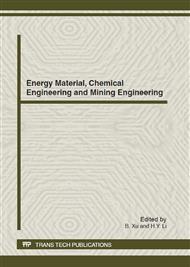p.81
p.85
p.89
p.93
p.97
p.101
p.105
p.109
p.115
The Study of Iron Catalyst for Ammonia Synthesis in Chemical Engineering
Abstract:
The temperature programmed desorption technique is used to study the hydrogen adsorption on the catalytic surface of fused iron catalysts with different oxide precursors in chemical engineering. The different catalysts desorption active energy, desorped temperature and their amouts desorped have been attained. The desorption energies, desorped temperatures and desorption amounts have been related to the iron ratio (Fe2+/Fe3+). It is compared with the curve of ammonia synthesis activity against iron ratio. The inhibition of hydrogen in the ammonia synthesis reaction is verified, the adsorption intensity of hydrogen controls the inhibition to nitrogen adsorption
Info:
Periodical:
Pages:
97-100
Citation:
Online since:
October 2012
Authors:
Keywords:
Price:
Сopyright:
© 2012 Trans Tech Publications Ltd. All Rights Reserved
Share:
Citation:


